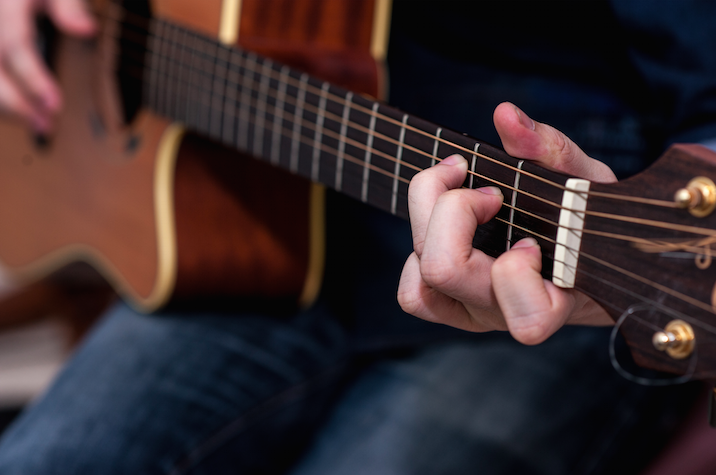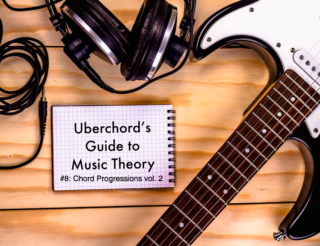Three good reasons to throw away the guitar pick
Author: Lucas Frost

Chloe Marshall has already given us a great overview of fingerpicking technique, as well as some advice on using a pick. Here I’ll be looking at some good reasons to practice with your fingers and ditch the guitar pick altogether. By the way, if you want to practice your chord-play (with or without pick), we highly recommend our guitar learning app Uberchord.
Guitar Picks have obvious advantages – they help increase your playing speed, produce a clear, defined tone and increase your volume considerably, which is good for when you are strumming around a campfire with some mates. They can be worn around your neck, reminding your peers that you are a guitarist, and make for a good excuse to walk into any music shop, spend hours playing Gibsons through vintage tube amps, and get away with it by buying a plectrum or two… But then again, some of the world’s best guitarists play without a pick. Maybe they can convince you that you are best served without the piece of plastic?
Table of Contents
1. That Thumb Tone: Wes Montgomery
Mr. Montgomery was one of the best, most influential guitarists ever – but unless you’re into Jazz, you may have never heard of him. With tremendous swing feel, superb chord-work and an ear for melody, arguably his most distinguishing characteristic was his tone. He achieved this through a simple technique: he played with his thumb.
Born in Indianapolis, he only started playing guitar in his late teens, working during the day and practicing at home late at night. Initially he used a pick, but was keeping his wife awake; he continued playing, this time using the fleshy part of his thumb to keep the noise low. After a while a callus formed on his thumb, and by this time young Wes had developed his signature sound.
This video demonstrates Wes’ mastery of the guitar, his large, double-jointed thumb, and how he anchors his hand onto the pickguard to give him more control. It also shows how variations of his thumb technique can produce quite distinct tonal characters. He has three main modes of playing:
- Chordal: with his thumb at a flatter angle to the strings, using a light, broad strumming pattern, Wes gets a delicate, soft tone. This is ideal for chord-work, where the guitar fuses with other instruments and adds colour and texture.
- Melodic: at 1:58, he turns his thumb inwards, pointing it towards the strings for more precise tones. The callus on his finger gives his warm sound the presence, focus and clarity for “lead” playing.
- Octaves: subtle but so powerful, Wes plays his signature octaves at 2:45. Here he plays the melody using his index finger, doubling the notes with the pinky and muting all unwanted strings with the underside of his fingers. The resulting sound combines two notes with the sound of his thumb whispering over the muted strings, which adds some butter to the tone.
Wes Montgomery’s tone is round, full-bodied and warm, perfect for his smooth modal melodies. It is a hard technique to master, especially for faster passages and for the octaves. Even Wes makes a mistake at 5:34, which he charmingly laughs off. To play like Wes, it helps to have heavy-gauge, flat-wound strings.
2. Claw-hammer Rhythm: Mark Knopfler
Of Dire Straits fame, Mark Knopfler need little introduction. He is the author of countless iconic solos, and has an instantly recognizable tone. He is left-handed but plays standard, right-handed guitar, and he is well-known for playing with his fingers, not a pick.
When Mark began playing guitar in 1960s Northumberland he couldn’t afford the equipment to join a loud rock band. Instead he played in folk-bands, where he learnt to play “claw-hammer” style: thumb plays the accompaniment on the lower strings while the index and middle fingers fill in the gaps on the upper strings; ring-finger and pinky anchor the hand onto the body. Essentially, claw-hammer style is a rhythm thing, helping to keep a chunky consistency for a solid rhythm foundation.
Mark developed this technique further by switching the position of his fingers: now the thumb was up there playing the high notes, and the middle/index fingers on the lower strings. Once he had built up his speed and control, this fingerpicking technique shaped some of classic rock’s most memorable solos, such as Sultans of Swing. If they are well-trained, three fingers are better than one pick!
A good example for this technique is the iconic riff of Money for Nothing, which seems easy to play, but is actually devilishly difficult to get right. You can see the shape of the hand, with the index/middle finger “claw-hammer” shape alternating with the thumb, stabilized by the ring-finger anchor. It allows Mark to have a confident control over each string’s articulation, emphasizing some and blocking others out whilst simultaneously keeping the stomping drive going. It gives it a distinct rhythm and tone which really make the riff come alive.
3. Electric Guitar Wizardry: Jeff Beck
So Jeff Beck is not just a guitar legend who has jammed with the greatest and influenced over five decades of rock music; he also plays in a unique and fluid manner, using all fingers to shape his playing to the maximum of a guitar’s abilities.
He started out in 1960s London, soon joining the Yardbirds, the band which saw three guitar legends (Eric Clapton, Jeff Beck and Jimmy Page). In his early days his style was more blues-based, and he used a pick. But as his musical direction evolved, he ditched his pick in the 1980s, grabbing influences from jazz, electronica, “world” music and elsewhere to really explore the guitar’s capabilities as a sound-producing instrument. His fingerpicking technique is an important element of his sonic freedom.
Similar to Wes Montgomery, Jeff plays mostly with his thumb. Unlike Wes, Jeff Beck has a “normal” shaped thumb, and slightly longer fingernails to give him a sharper tone. To play fast passages he may play with both thumb and index finger, or even hold his fingers as though he were holding a pick, using his index fingernail as a plectrum. The video I have chosen is a little corny but it illustrates some of his other techniques quite well.
- Expression: Jeff starts with a trick called “violining”, where he raises the note’s volume immediately after plucking it, allowing each note to gently flourish in a delicate crescendo. He does this by manipulating the volume knob with the ring-finger.
- Pitch-bending: throughout most of this passage, he holds the whammy bar in his middle and index finger and adds an almost singing fluidity to his playing.
- Articulation: Jeff changes the timbre and sound of his playing very subtly throughout the video. Sometimes playing harmonics that soar above the rest, more assertive melodic lines with his nails, or more gnarly tones by “throwing” his fingers at the strings.
Of course, what makes his technique so special is when he does all these things at the same time, creating a very expressive style of playing that gives the guitar a new voice (and with remarkably few effects).
Guitar Picks are great and I love using their assertiveness. But, as these three guitarists demonstrate, there is so much to gain by practicing with your fingers, in terms of tone, flexibility and musical expression. So leave your picks in their case and get those fingers moving!
Playing without a guitar pick does require a different perspective on the instrument. It helps to see new ways to play chords, as well as having more musical tools to have your fingers work with. Some of our free blog articles will help with concepts like the d# minor scale guitar, mmm mmm mmm mmm chords, and playing proper guitar hammer on pull offs.








Its true fingers can add lots of subtle harmonics and expand techniques you can use for your playing and there are truly quite some great examples like , KNophler, Beck, Wes but for me biggest genius on acoustic is late Paco de Lucia, his style was perfect for fingerstyle techniques and he was absolute master and he managed to play rhytms and solos at the same time at highest speed. TO play only with fingers is useful for more acoustic music but also for electric guitar music, though in later case for more soft styles like acoustic rock, jazz, folk rock pop rock and similar styles. For faster and more intense styles of rock, use of plectrum is still must, but still there are some parts where fingers could be used to add some spice to music ( like tapping for fast leads in hard rock and metal, rock ballads and for parts of songs where you calm down and just fingerpick and similar instances… Its also conected what nature you have, for instance JImi Hendrix used mostly pick but his sounds and all infinite harmonies is still unmatchable…. IN time of Hnedrix there was still no hard rock and metal sounds and styles but as guitar player Hendrix had same intensity as hard rock and metal players and imagination of jazz players– his amazing music expansion is “guilty” for his genius ! Also Jimmy Page used fingers for some aoustic parts, yet intensity of Led Zep music was too much too use just fingers, he would probably bleed daily ;) …Also myself , like to play more intense styles with combination of soft quiet parts..I am very happy with guitar picks for hard rock fast riffs and leads I mostly play, but I remain open and whenever is chance to add fingerstyle technique into song I use it, it add more spice and expand possibilities in music. Pick, fingers and guitar strings have to become one, then pick use is very rewarding and pick sound very natural ! But in case of some exreme metal styles like metal core etc there is too much noise and pick is just some tool its not merged with hands and guitar, so all we hear is horrible artifiicial noise…
So for few guitarists with special fingers and softer styles fingerstyle playin is cool sounding and Knophler wouldnt sound same with pick…and for others like myself pick is a must and joy to use, but sometimes use fingerstyle to add some spices into music, and those who play strictly only with pick might expand a little, cause intense parts have more value if there are also quiet and soft parts played with fingers !
Cheers :-)
Another example for not using a pick, and for me the most applicable, can be found in the solo performances of Joe Pass. No discussion of this subject should ignore him. His work is found in abundance on youtube. His ability to play a bass line with his thumb while playing a full improvisation with his fingers is unsurpassed.Check out his online lessons too, which assume you already know how to play guitar and the basics of music theory and which provide a glimpse into his dry sense of humor as well.
Very nice article shared by you. I am just the beginner and don’t have much experience. I love to play guitar. So I was searching for tips to learn guitar playing. I am using guitar pick, but I didn’t know the reasons to avoid this. Well I have recently used coated strings and guitar saddle screws. I think I should try to use finger. I am little afraid about the injuries. Thanks for sharing the article.
Yes,I need advice.I have played metal guitar since 1997 with picks but in the last 18 months to 2 years have struggled with them.I seem to have possible arthritis in my right elbow and just cannot hold a pick firmly between thumb and index with proper control aymore.Maybe theres a damaged nerve or tendon or something.I am trying to re teach myself to play fingers only but to play power metal like that will be such a challenge.I wonder if my right arm problem is fixable.But here in Switzerland where I ex pated to to go see a doctor is a ridiculous cost financially.But from a brief check on google it seems there ARE some metal guitarists out there who are pickless….then theres the possibility of using a wearable pick.Is this better on thumb or on index finger.Please email me if you can suggest anything.
Jon, You likely have tendonitis from intense repetitive playing I’m guessing for speed/shredding metal rhythm etc, you are flexing you fingers holding the pick quite tightly and a lot of alternate rapid motion at your wrist and forearm. I suggest seeing a sports med doctor and then probably a physical therapist to rehab your right arm. This is the set up for this kind of pain syndrome. It also occurs with pianists who play aggressively flexing at the forearm and holding the hand rigid to play repetitive octaves in sculpt passages.
The fingerstyle playing is likely going to be less chronically injurious. You will likely have to rethink how you play though. Few guitarists are as fast finger style for single note line playing as those who use a pick. The above article is an excellent reference.
Most importantly REST your right hand for a bit. That does not mean do not play at all, but maybe about 2 weeks of not playing while you are waiting to see the doctor would be of benefit in the long run and may answer some questions.
I am not a sports med doctor but I am a retired pediatrician and I saw some patients with similar complaints due to similar patters of use. I also play guitar and keys. I would strongly urge aggressive NONSURGICAL treatment. Surgery for these problems has very mixed results and may make it worse. (review Keith Emerson’s story about his right hand/arm)
I hope this helps.
Matthew Knight
Hi, have you tried a Black Mountain thumb pick? Check it out on you tube, or their website. Having learnt on an acoustic and played using my fingers, I’ve changed to an electric and realised I need to try and get to grips with a pick, but I struggle! The BM pick is wearable and easier to get the hang of. Currently they only have the one size which is quite thick at 1.5mms, but I contacted them by email to see if they plan to make other sizes and they said they will be bringing out a 0.80mm very shortly. Best of luck!